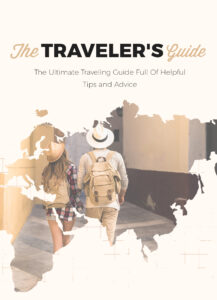The Art of Hitchhiking Safely Around the World

Looking for more amazing products? Check out our online store and explore our collection here! Happy shopping!
Before diving in, please note: This post is for informational purposes only. If you’d like to know more about how we approach topics, feel free to check out our friendly Disclaimer Page.
Hey there, amazing readers! 
We’re committed to delivering quality posts, and your support (even just sticking around despite the ads) means everything to us. So, bear with us, and thanks for helping us keep the good vibes rolling. Now, on to the fun stuff!
TRANSLATE BUTTON AT THE END OF THE ARTICLE
A Quick Overview
Hitchhiking has been a beloved mode of travel for wanderers seeking adventure and spontaneity.
It’s not just about getting from Point A to Point B; it’s a chance to connect with locals, experience new cultures intimately, and embrace the thrill of uncertainty.
However, one cannot ignore the importance of safety while hitchhiking.
In this article, we’ll explore the art of hitchhiking safely around the globe, from the joys of the journey to essential safety tips and everything in between.
Let’s dive in!
Discovering the Joys of Global Hitchhiking Adventures
Hitchhiking offers a sense of freedom that is tough to replicate.
Imagine standing on the roadside, thumb out, waiting for a stranger to stop and take you wherever they’re headed.
It’s exhilarating!
I’ve experienced this firsthand, and here are some joys I found along the way:
Connections: It’s fascinating to meet people from different walks of life.
Each ride is a new story.
I once shared a car ride with a retired schoolteacher who shared tales of her travels across Europe.
Cultural Exchange: Hitchhiking leads to unexpected conversations—about culture, food, and traditions.
There’s something special about learning about a place from a local’s perspective.
Cost-Effective Travel: Let’s face it: travel can get pricey.
Hitchhiking is a budget-friendly way to explore without breaking the bank.
Adventure: Every ride is an adventure.
The anticipation of who will stop and where you’ll end up adds a layer of excitement.
Flexibility: With hitchhiking, your itinerary can change on a whim.
I remember deciding to take a detour to a beach after a kind driver suggested it.
Nature’s Playground: You often find yourself in beautiful landscapes as drivers take you through scenic routes.
I’ve seen breathtaking sunsets and lush forests, all while on the road.
Bonding Moments: Sharing a journey with a stranger often creates a bond.
Sometimes, I still keep in touch with those I met along the way.
Self-Reliance: It encourages you to trust your instincts and develop problem-solving skills.
You learn to think on your feet.
Simplicity: In a world full of technology, hitchhiking strips travel down to the basics—just you, the open road, and the kindness of strangers.
Memorable Stories: Each ride brings a story that will last a lifetime.
Like that time I got a lift from a band headed to a music festival—what a night that turned out to be!
Essential Safety Tips for First-Time Hitchhikers
Safety should be your top priority when embarking on a hitchhiking adventure.
Discover "The Traveler’s Guide: Your Ultimate Companion for Every Adventure
"
Here are some essential tips I learned from my experiences to help you stay safe:
Choose Your Spot Wisely: Stand in a location where cars can easily pull over, like near gas stations or rest areas.
Avoid busy highways where drivers might feel rushed.
Trust Your Instincts: If something feels off about a driver or their vehicle, don’t hesitate to decline the ride.
Your gut feeling is often your best guide.
Travel Light: Bring only what you need.
A small backpack with essentials makes it easier to move quickly if needed.
Share Your Plans: Inform friends or family of your route and estimated arrival times.
A simple message can make a huge difference.
Stay Sober and Alert: Avoid hitchhiking when you’re tired or under the influence.
Being alert helps you assess situations better.
Dress Appropriately: Wear clothes that are comfortable and suitable for the weather.
Bright colors can make you more visible.
Keep Important Items Close: Keep your phone, money, and identification on you at all times.
A small pouch can be handy for this.
Use Technology: Apps like Google Maps can help you track your journey and share your location with someone you trust.
Prepare for the Unexpected: Always have a backup plan in case you don’t get a ride for a while.
Bring snacks and water to stay energized.
Learn Basic Phrases: If you’re in a foreign country, knowing a few key phrases in the local language can go a long way in communicating with drivers.
Picking the Right Destinations for Hitchhiking Fun
Not all places are equal when it comes to hitchhiking.
Some destinations are more welcoming and easier to navigate.
Here’s how to choose the right ones:
Friendly Cultures: Countries with a reputation for hospitality, like Iceland, are great places to start.
I felt incredibly welcomed there.
Tourist Hotspots: Areas frequented by travelers often have more hitchhikers and rides available.
Places near national parks or famous landmarks are ideal.
Roadside Attractions: Try hitchhiking near quirky roadside attractions.
Not only do they attract tourists, but drivers often stop just to check them out.
Safe Environments: Research areas known for being safe for hitchhikers.
Some regions have a higher incidence of friendly drivers.
Strong Hitchhiking Communities: Some countries, like New Zealand and Colorado in the U.S., have established hitchhiking communities.
Local websites or forums can provide insights.
Events and Festivals: Timing your hitchhiking trip to coincide with festivals can increase your chances of getting a ride.
People are generally in high spirits during these times.
Public Transport Connections: Hitchhiking near bus or train stations can help you find rides, as travelers often stop to pick up others.
Open Roads: Look for routes with fewer restrictions on hitchhiking.
Some places may have laws against it, so be sure to check first!
Seasonal Considerations: Certain times of the year, like summer, might yield better hitchhiking opportunities.
Everyone’s on the move!
Personal Preferences: Ultimately, choose destinations that intrigue you.
Your enthusiasm for a place can attract friendlier drivers.
How to Prepare Yourself for a Hitchhiking Journey
Preparation can make or break your hitchhiking experience.
Here’s how I get ready for my trips:
Research Your Route: Know the major highways and towns along your journey.
Having a rough map in mind helps you navigate better.
Study Local Laws: Different countries have various regulations on hitchhiking.
Understanding these can save you from legal troubles.
Gather Travel Documents: Ensure your passport, visas, and any necessary IDs are in order.
I always keep photocopies in my bag just in case.
Plan for Accommodation: Sometimes, you might not find a ride immediately.
Knowing where you can stay overnight is essential.
Create a Checklist: List all the items you need.
This ensures you don’t forget anything important before you leave.
Choose the Right Time: Early morning or late afternoon often provides the best chances of getting a ride.
Peak hours can be hectic.
Practice Your Signs: A simple “To [Destination]” on a piece of cardboard can attract the right drivers.
Make sure it’s legible from a distance!
Set Your Mindset: Prepare mentally for the journey.
It’s all about being open to new experiences and ready for surprises.
Stay Connected: Make sure your phone is fully charged and consider a portable charger.
You might need to reach out to someone or use navigation.
Get in Shape: If you plan on long walks between rides, a little physical preparation can go a long way.
The Best Gear for a Safe and Comfortable Ride
Having the right gear can enhance your hitchhiking experience.
Here’s a list of essentials I carry with me:
A Reliable Backpack: A durable but lightweight backpack keeps your belongings organized.
I prefer one with multiple compartments for easy access.
Water Bottle: Staying hydrated is crucial.
Opt for a reusable, collapsible bottle to save space.
Snacks: Pack non-perishable snacks like nuts or granola bars.
Trust me, they can offer a much-needed energy boost.
Travel Blanket or Sleeping Bag: For unexpected overnight stays, a compact travel blanket can make a world of difference.
First Aid Kit: Always be prepared for minor injuries.
A basic kit can help you deal with cuts, scrapes, or headaches.
Comfortable Footwear: Your feet will take a beating if you’re walking a lot.
Invest in a pair of sturdy, comfortable shoes.
Maps and Guidebooks: While technology is great, having a paper map can be invaluable if you find yourself without service.
Portable Charger: Keeping your devices charged is essential for communication and navigation.
Rain Gear: A lightweight poncho or packable rain jacket can save you from getting soaked, which can be a real mood-breaker.
Personal Safety Devices: Consider carrying a whistle or even a personal alarm for added security.
Reading the Signs: How to Catch a Ride Effectively
Catching a ride is an art form in itself.
Here’s how I’ve mastered the skill over time:
Positioning Yourself: Stand where drivers can easily see you and pull over.
Gas stations or slow bends in the road work well.
Using Your Body Language: Smile and look approachable.
A friendly demeanor makes drivers more likely to stop.
Signage: Use clear, large signs indicating your destination.
I often write in bold, large letters so it’s visible from a distance.
Eye Contact: Engage with drivers as they approach.
A nod or a wave can signal your readiness for a ride.
Be Patient: Sometimes, it may take a while to get a lift.
Use the time to relax and enjoy the scenery.
Know When to Move: If you’re not getting rides after a long period, try moving to a new location.
A change in scenery can work wonders.
Ride Along with Fellow Hitchhikers: Sometimes, hitching with a buddy can attract more drivers.
Safety in numbers, right?
Be Gracious: If someone stops, express gratitude.
Whether you get the ride or not, kindness leaves a lasting impression.
Consider Your Appearance: A clean, well-kept look can make you more appealing to drivers.
No one wants to pick up someone who looks disheveled.
Stay Positive: A cheerful attitude can be contagious.
If you approach hitchhiking with joy, you’re more likely to attract positive experiences.
Building Rapport: Smiling Your Way to a Lift
Once you’ve got a driver’s attention, building rapport can make or break the ride.
Here’s how I do it:
Start with a Smile: A genuine smile can go a long way in making drivers feel comfortable.
It’s often the first impression that counts.
Introduce Yourself: A simple introduction can set a friendly tone.
I usually share a little about where I’m from and where I’m headed.
Ask Questions: Show genuine interest in the driver’s life.
A few insightful questions can lead to engaging conversations.
Share Stories: People love stories!
Share a fun anecdote or two about your travels.
It creates a connection.
Respect Personal Space: Remember, you’re a guest in their vehicle.
Be mindful of their comfort and personal boundaries.
Be Polite and Grateful: Always thank your driver at the end of the ride.
A little gratitude can leave a lasting positive impression.
Learn About Their Journey: Ask them what brought them to this point.
People enjoy sharing their experiences.
Listen Actively: Show that you value what they’re saying.
Nodding or asking follow-up questions demonstrates interest.
Be Yourself: Authenticity resonates well.
Don’t try to be someone you’re not; just be the best version of yourself.
Enjoy the Silence: Sometimes, silence is golden.
If the conversation isn’t flowing, enjoy the moments of peace together.
Staying Alert: Recognizing Safe and Unsafe Drivers
Being able to gauge who is safe to ride with is crucial.
Here’s how I assess drivers:
Observe the Vehicle: A well-maintained car often indicates a responsible driver.
Look for signs of care—cleanliness, working lights, etc.
Watch for Aggression: If a driver seems impatient or aggressive, it’s wise to decline the ride.
Safety first!
Trust Your Gut: If you feel uneasy, it’s okay to say no.
Your instincts are often your best ally in these situations.
Listen to Their Tone: Are they friendly and calm?
A positive tone often suggests a safe and pleasant ride.
Inquire About the Route: A responsible driver will know where they’re going.
Asking them about their route can provide insight into their intentions.
Look for Familiarity: Drivers who seem familiar with the area may be more reliable than someone who looks lost.
Check for Passengers: A driver who brings friends along can sometimes be safer, as they’re less likely to be up to no good.
Don’t Hesitate to Leave: If something feels off, politely exit the situation.
It’s better to be safe than sorry.
Evaluate Their Reaction: A driver who is put off by your hesitation might not be someone you want to be with.
A respectful driver will understand your concerns.
Keep Your Distance Until Ready: Don’t jump into the car until you feel comfortable.
Take your time to assess the situation first.
Navigating Cultural Differences While Hitchhiking
Traveling through different countries means encountering various cultures.
Here’s how to navigate those differences effectively:
Research Before You Go: Understanding local customs can prevent misunderstandings.
A little preparation goes a long way.
Learn Basic Phrases: Knowing a few words in the local language shows respect and can help you connect with drivers.
Embrace Local Etiquette: Different cultures have unique norms regarding hospitality.
Being aware can create a more positive experience.
Be Open-Minded: Adaptability is key.
If someone offers you food or drink, graciously accept it, even if it’s unfamiliar.
Respect Local Laws: Some places have specific rules about hitchhiking.
Always follow the local guidelines to avoid trouble.
Observe Social Cues: Pay attention to how locals interact.
Mimicking their gestures can help you blend in better.
Be Patient with Language Barriers: Miscommunication can happen.
Use gestures or drawings if necessary, and don’t get frustrated.
Show Appreciation: A simple thank you in the local language can go a long way.
It shows you value their kindness.
Adapt Your Approach: What works in one country may not work in another.
Be flexible and willing to change your style as needed.
Share Your Culture: If the opportunity arises, share aspects of your culture.
This can foster a sense of connection and curiosity.
What to Do in Case of Emergency on the Road
Emergencies can happen, even on the most joyful journeys.
Here’s how to handle them:
Stay Calm: Panic can cloud your judgment.
Take a deep breath and assess the situation.
Have Emergency Contacts Ready: Keep important phone numbers saved in your phone and written down somewhere accessible.
Know Your Location: Familiarize yourself with the area.
This can help if you need to ask for help or give someone directions.
Trust Your Instincts: If you feel unsafe, don’t hesitate to move to a more populated area or seek help.
Find Local Authorities: If you’re in trouble, approach local police or authorities.
They’re usually there to help.
Use Your Phone Wisely: In case of emergency, use your phone to call for help or to find directions.
Ensure you have a backup battery.
Carry a Whistle: A whistle can be a lifesaver in emergencies.
It’s loud and can alert others if you’re in distress.
Identify Nearest Help Points: Familiarize yourself with nearby hospitals or police stations along your route.
Stay Visible: If you’re stranded, stay in a visible area.
This makes it more likely for someone to notice you.
Document Everything: If something serious happens, document the details.
This can be helpful for authorities later.
Sharing Your Hitchhiking Stories and Experiences
Nothing complements a hitchhiking journey quite like sharing the experiences afterward.
Here’s how I love to share the tales:
Social Media: Platforms like Instagram or Facebook can showcase your adventures.
A few captivating photos can fascinate friends and followers.
Travel Blogs: If you enjoy writing, consider starting a travel blog.
It’s a great way to connect with fellow travelers and share tips.
Community Forums: Joining hitchhiking or travel forums can connect you with like-minded individuals who appreciate your stories.
Meetups: Share your experiences at local travel meetups.
Many travelers love swapping stories, and it can lead to great conversations!
Videos: If you’re comfortable, document your journey on platforms like YouTube.
Visual storytelling can be engaging and inspiring.
Postcards: Send postcards to friends and family detailing your adventures.
It adds a personal touch that they’ll cherish.
Host Events: Organize a storytelling night where you can recount your hitchhiking tales over snacks.
Friends love a good story!
Join a Podcast: Many travel podcasts seek guest speakers.
Sharing your adventures can inspire others to embrace the open road.
Create a Scrapbook: Collect photos, ticket stubs, and notes from your journeys.
It’s a creative way to compile your memories.
Encourage Others: Share your experiences with friends who might be considering hitchhiking.
Your insights can empower them to take the plunge!
Embracing the Freedom of the Open Road Safely
At the end of the day, hitchhiking is about freedom.
It’s an adventure that allows us to connect with the world in a meaningful way.
As I reflect on my journeys, I’m constantly reminded of the beauty found in spontaneous travels.
Hitchhiking doesn’t have to be scary if you prioritize your safety.
With the right mindset, preparation, and awareness, you can enjoy the thrill of the open road while staying secure.
Let’s celebrate the joy of meeting new people and discovering new places.
So, pack your bags, keep your smile ready, and hit the road—safely!
Conclusion
Hitchhiking can be a delightful way to explore the world, full of stories, connections, and unexpected adventures.
However, the importance of safety cannot be overstated.
By preparing adequately, staying alert, and treating others with kindness, you can ensure that your hitchhiking experiences are as rewarding as they are exciting.
So, whether you’re planning your first trip or looking to refine your skills, remember to enjoy the journey, embrace the freedom, and stay safe!
Happy travels!

The Enlightenment Journey is a remarkable collection of writings authored by a distinguished group of experts in the fields of spirituality, new age, and esoteric knowledge.
This anthology features a diverse assembly of well-experienced authors who bring their profound insights and credible perspectives to the forefront.
Each contributor possesses a wealth of knowledge and wisdom, making them authorities in their respective domains.
Together, they offer readers a transformative journey into the realms of spiritual growth, self-discovery, and esoteric enlightenment.
The Enlightenment Journey is a testament to the collective expertise of these luminaries, providing readers with a rich tapestry of ideas and information to illuminate their spiritual path.
Our Diverse Expertise
While our primary focus is on spirituality and esotericism, we are equally passionate about exploring a wide range of other topics and niches 

To ensure we provide the most accurate and valuable insights, we collaborate with trusted experts in their respective domains 
Our blog originally focused on spirituality and metaphysics, but we’ve since expanded to cover a wide range of niches. Don’t worry—we continue to publish a lot of articles on spirituality! Frequently visit our blog to explore our diverse content and stay tuned for more insightful reads.
Hey there, amazing reader! 
Check out our store here and take a peek at some of our featured products below! Thanks for being awesome!











